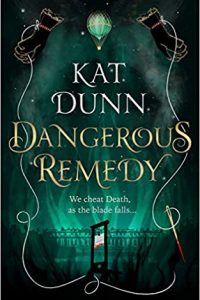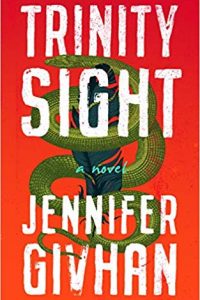Russell Letson Reviews The Menace from Farside by Ian McDonald
 The Menace from Farside, Ian McDonald (Tor.com Publishing 978-1-250-24779-7, $14.99, tp) November 2019. Cover by Richard Anderson.
The Menace from Farside, Ian McDonald (Tor.com Publishing 978-1-250-24779-7, $14.99, tp) November 2019. Cover by Richard Anderson.
Ian McDonald’s The Menace from Farside is also an extension of ideas – and specific settings – from the author’s previous work, in this case his Luna sequence. The Menace from Farside is set earlier, in 2089, when much of the lunar infrastructure is still a-building, but with its wildly multicultural-libertarian social machinery already up and running. The reader is dumped into this milieu with minimal explanation of circumstances (and without the aid of the novels’ glossaries) because the first-person narrator, Cariad Corcoran, is a teenager who is telling her story to a psychological-counsellor AI.
Exactly why Cariad has to explain herself to a shrink (even if only a mechanical one) is the question, and the answer is telegraphed on the first page: “We’re down in Hypatia with thirty minutes of air and the mother of radiation storms coming at us.” Backing up and getting to that crisis-point gives us a kids’-eye view of lunar society outside of (or at least before the worst of) the cutthroat inter-Dragon-clan feuding featured in the novels – though there is small-scale rivalry enough when a new link in Cariad’s family’s ring marriage brings along a new step-sister, Sidibe Sisay, to whom Cariad takes an immediate dislike: a mixture of envy (height, hair, skin, fashion sense, flying, boobs) and competition for leadership in her group of close siblings.
Like its novel-length companions in the Luna sequence, The Menace from Farside has Heinlein’s fingerprints all over it, not just in the title echo (see “The Menace from Earth”), but in the polyamorous domestic setup of ring marriage (a cousin to line marriage in The Moon Is a Harsh Mistress) and the kids-on-their-own lunar-adventure plot (“Nothing Ever Happens on the Moon”). Another, perhaps less obvious, non-SF echo is of The Catcher in the Rye, another first-person narrative of a part-smart kid trying to explain adolescent behavior and attitude to the adult world.
Cariad is smart and articulate (not to say mouthy), but still recognizably, imprudently kid-like. She feels simultaneously protective of and superior to her brothers, the neko (cat-identified) Kobe and the neuro-atypical Jair, and she finds Sidibe’s insertion into their lives disruptive and a challenge to her position. Her solution is to assert her dominance by proposing a clandestine, kids-only expedition to the site of the first moon landing for a photo-op, with herself as leader. The whole thing is carefully and (because no grownup would approve) secretly planned, and the adventure goes fine, until it quite dangerously doesn’t, which is why Cariad ends up explaining herself to the AI shrink.
Much of the story’s mystery is tied up with the kids’ precise sibling relationship and the nature of ring marriage. It’s nearly a third of the way through the book before McDonald has mercy on the reader and starts to explain the marital topology and add enough details to fill out Cariad’s domestic environment. But those details really can wait, since the heart of the story is how these recognizable teenagers interact, how they deal with the adult world, how – despite their general competence in navigating their deadly physical environment – they nevertheless nearly get themselves killed several times over in the course of their adventure. And how they manage to survive.
The novella is less an extension of the Luna sequence than a filling-in, a picture of what it might be like to be an ordinary, if rather bolshy kid (rather than a dynastic pawn) in that world of reinvented familial and social structures. And, in its avoidance of the kinkier areas of lunar affectional relations, it qualifies for a YA-fiction nihil obstat. That may be a bug or a feature for grownups in the audience, but it does not really affect the quality of the adventure itself or the texture and detail of the world that it supports. It’s a slightly safer guided tour, a retro-introduction to an evolving culture that we know will get even more dangerous and exotic and intriguing by the time Cariad is grown up.
Russell Letson, Contributing Editor, is a not-quite-retired freelance writer living in St. Cloud, Minnesota. He has been loitering around the SF world since childhood and been writing about it since his long-ago grad school days. In between, he published a good bit of business-technology and music journalism. He is still working on a book about Hawaiian slack key guitar.
This review and more like it in the October 2019 issue of Locus.
 While you are here, please take a moment to support Locus with a one-time or recurring donation. We rely on reader donations to keep the magazine and site going, and would like to keep the site paywall free, but WE NEED YOUR FINANCIAL SUPPORT to continue quality coverage of the science fiction and fantasy field.
While you are here, please take a moment to support Locus with a one-time or recurring donation. We rely on reader donations to keep the magazine and site going, and would like to keep the site paywall free, but WE NEED YOUR FINANCIAL SUPPORT to continue quality coverage of the science fiction and fantasy field.






